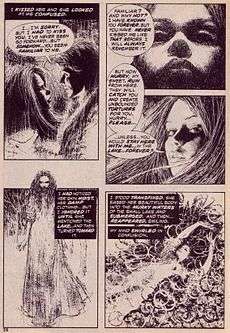Luis García Mozos
| Luis García | |
|---|---|
| Born |
Luis García Mozos 1946 Puertollano, Spain |
| Nationality | Spanish |
| Area(s) | artist |
Notable works | Creepy, Eerie, Vampirella |
| Awards | Warren Award, 'Best Art in a Story', 1972 |
Luis García Mozos (born 1946) is a Spanish comic book artist.
Career

More widely known in English as just Luis García, he was born in Puertollano, Spain in 1946. García began his career drawing European romance comics for Fleetway. In the 1960s, he joined the well known Spanish agency Selecciones Illustradas. In 1971 García joined Warren Publishing, where he drew nine stories for Creepy, Eerie and Vampirella. García's first story published for Warren, The Men Who Called Him Monster (Creepy #43, January 1972) is notable as having the first interracial kiss in mainstream comics. Ironically this kiss, which occurred between a black detective and a white teenager he was interviewing happened only because García misunderstood the line "This is the clincher" in writer Don McGregor's script.[1] Another story of García's, Welcome to the Witch's Coven (Vampirella #15, January 1972) won the Warren award for best art in a story for 1972.
García left Warren in 1973 to join the Franco-Belgian comics magazine Pilote, where he teamed up with writer Víctor Mora. Five of these stories would be reprinted in Vampirella in 1975 (Around the Corner... Just Beyond Eternity!, The Wolves at War's End, Love Strip, Janis and The Secret Legacy of Gaslight Lil!). The Wolves at War's End was rated as the second best story to ever appear in a Warren magazine by David A. Roach, co-author of The Warren Companion. Love Strip also appeared on his list in tenth place.[2]
García's art would later appear in La Isla del Tesoro (1977), La Gran Aventura (1978), Etnocidio (1979) and Chicharras (1985). He was one of the founders of the magazines Trocha and Rambla. After Rambla went out of business in 1985, García ended his career as a comic book artist to focus on painting.[3]
Selected bibliography
- Davy Crocket (1961)
- 5 Por Infinito (1968)
- Aventuras en la Selva (1969)
- Creepy issues 43,46,47 (1972)
- Eerie issues 41,43 (1972)
- Vampirella issues 15,17,18,20,21,42-45,47 (1972,1975)
- Pilote (1973–1980)
- La Isla del Tesoro (1977)
- La Gran Aventura (1978)
- Etnocidio (1979)
- Totem (1981)
- Heavy Metal (1982)
- Chicharras (1985)
References
- ↑ The Warren Companion by David A. Roach and Jon B. Cooke. TwoMorrowsPublishing. 2001. p. 114.
- ↑ The Warren Companion by David A. Roach and Jon B. Cooke. TwoMorrowsPublishing. 2001. pp. 253–4.
- ↑ Lambiek Comiclopedia. "Luis García".
Sources
- The Warren Companion, by David A. Roach and Jon B. Cooke
- Luis García publications in Pilote BDoubliées (French)
External links
- Luis García biography on Lambiek Comiclopedia